Toyota Sienna Service Manual: System Too Lean/ System Too Rich
DTC P0171 System Too Lean (Bank 1)
DTC P0172 System Too Rich (Bank 1)
DTC P0174 System Too Lean (Bank 2)
DTC P0175 System Too Rich (Bank 2)
DESCRIPTION
The fuel trim is related to the feedback compensation value, not to the basic injection time. The fuel trim consists of both the short-term and long-term fuel trims.
The short-term fuel trim is fuel compensation that is used to constantly maintain the air-fuel ratio at stoichiometric levels. The signal from the Air-Fuel Ratio (A/F) sensor indicates whether the air-fuel ratio is rich or lean compared to the stoichiometric ratio. This triggers a reduction in the fuel injection volume if the air-fuel ratio is rich and an increase in the fuel injection volume if it is lean.
Factors such as individual engine differences, wear over time and changes in operating environment cause short-term fuel trim to vary from the central value. The long-term fuel trim, which controls overall fuel compensation, compensates for long-term deviations in the fuel trim from the central value caused by the short-term fuel trim compensation.
If both the short-term and long-term fuel trims are lean or rich beyond predetermined values, it is interpreted as a malfunction, and the ECM illuminates the MIL and sets a DTC.
|
DTC No. |
DTC Detection Condition |
Trouble Area |
| P0171 P0174 |
With warm engine and stable air-fuel ratio feedback, fuel trim considerably in error to lean side (2 trip detection logic) |
|
| P0172 P0175 |
With warm engine and stable air-fuel ratio feedback, fuel trim considerably in error to rich side (2 trip detection logic) |
|
HINT:
- When DTC P0171 or P0174 is set, the actual air-fuel ratio is on the lean side. When DTC P0172 or P0175 is set, the actual air-fuel ratio is on the rich side.
- If the vehicle runs out of fuel, the air-fuel ratio is lean and DTC P0171 or P0174 may be set. The MIL is then illuminated.
- When the total of the short-term and long-term fuel trim values is within the malfunction threshold (and the engine coolant temperature is more than 75C [167F]), the system is functioning normally.
MONITOR DESCRIPTION
Under closed-loop fuel control, fuel injection volumes that deviate from those estimated by the ECM cause changes in the long-term fuel trim compensation value. The long-term fuel trim is adjusted when there are persistent deviations in the short-term fuel trim values. Deviations from the ECM's estimated fuel injection volumes also affect the average fuel trim learning value, which is a combination of the average short-term fuel trim (fuel feedback compensation value) and the average long-term fuel trim (learning value of the air-fuel ratio). If the average fuel trim learning value exceeds the malfunction thresholds, the ECM interprets this as a fault in the fuel system and sets a DTC.
Example: The average fuel trim learning value is more than +35% or less than -35%, the ECM interprets this as a fuel system malfunction.

MONITOR STRATEGY

TYPICAL ENABLING CONDITIONS
Fuel-trim:

TYPICAL MALFUNCTION THRESHOLDS
Fuel trim:

WIRING DIAGRAM
Refer to DTC P2195
INSPECTION PROCEDURE
HINT: For use of the intelligent tester only: Malfunctioning areas can be identified by performing the A/F CONTROL function provided in the ACTIVE TEST. The A/F CONTROL function can help to determine whether the Air-Fuel Ratio (A/F) sensor, Heated Oxygen (HO2) sensor and other potential trouble areas are malfunctioning.
The following instructions describe how to conduct the A/F CONTROL operation using the intelligent tester.
- Connect the intelligent tester to the DLC3.
- Start the engine and turn the tester on.
- Warm up the engine at an engine speed of 2500 rpm for approximately 90 seconds.
- Select the following menu items on the tester: DIAGNOSIS / ENHANCED OBD II / ACTIVE TEST / A/F CONTROL.
- Perform the A/F CONTROL operation with the engine in an idling condition (press the RIGHT or LEFT button to change the fuel injection volume).
- Monitor the voltage outputs of the A/F and HO2 sensors (AFS B1S1 and O2S B1S2 or AFS B2S1 and O2S B2S2) displayed on the tester.
HINT:
- The A/F CONTROL operation lowers the fuel injection volume by 12.5% or increases the injection volume by 25%.
- Each sensor reacts in accordance with increases and decreases in the fuel injection volume.
Standard voltage


NOTICE: The Air-Fuel Ratio (A/F) sensor has an output delay of a few seconds and the Heated Oxygen (HO2) sensor has a maximum output delay of approximately 20 seconds.
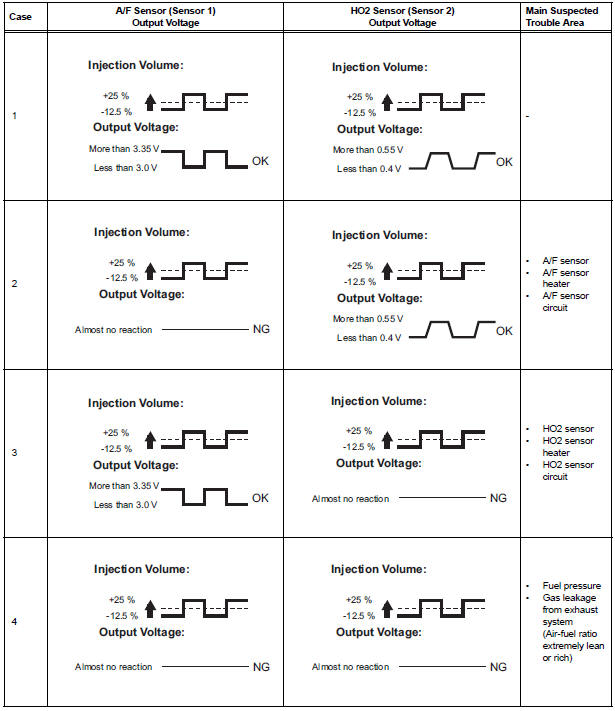
- Following the A/F CONTROL procedure enables technicians to check and graph the voltage outputs of both the A/F and HO2 sensors.
- To display the graph, select the following menu items on the tester: DIAGNOSIS / ENHANCED OBD II / ACTIVE TEST / A/F CONTROL / USER DATA / AFS B1S1 and O2S B1S2 or AFS B2S1 and O2S B2S2. Press the YES button and then the ENTER button. Then press the F4 button.
HINT:
- Read freeze frame data using the intelligent tester. The ECM records vehicle and driving condition information as freeze frame data the moment a DTC is stored. When troubleshooting, freeze frame data can be helpful in determining whether the vehicle was running or stopped, whether the engine was warmed up or not, whether the air-fuel ratio was lean or rich, as well as other data recorded at the time of a malfunction.
- A low A/F sensor voltage could be caused by a rich air-fuel mixture. Check for conditions that would cause the engine to run rich.
- A high A/F sensor voltage could be caused by a lean air-fuel mixture. Check for conditions that would cause the engine to run lean.
1 CHECK ANY OTHER DTCS OUTPUT (IN ADDITION TO DTC P0171, P0172, P0174 OR P0175)
- Connect the intelligent tester to the DLC3.
- Turn the ignition switch to the ON position and turn the tester on.
- Select the following menu items: DIAGNOSIS / ENHANCED OBD II / DTC INFO / CURRENT CODES.
- Read the DTCs.
Result

HINT: If any DTCs other than P0171, P0172, P0174 or P0175 are output, troubleshoot those DTCs first.
2 CHECK PCV HOSE CONNECTIONS
OK: PCV hose is connected correctly and is not damaged.
3 CHECK INTAKE SYSTEM
- Check the intake system for vacuum leakage.
OK: No leakage from intake system.
4 PERFORM ACTIVE TEST BY INTELLIGENT TESTER (A/F CONTROL)
- Connect the intelligent tester to the DLC3.
- Start the engine and turn the tester on.
- Warm up the engine at an engine speed of 2500 rpm for approximately 90 seconds.
- Select the following menu items on the tester: DIAGNOSIS / ENHANCED OBD II / ACTIVE TEST / A/F CONTROL.
- Perform the A/F CONTROL operation with the engine in an idling condition (press the RIGHT or LEFT button to change the fuel injection volume).
- Monitor the voltage outputs of the A/F and HO2 sensors (AFS B1S1 and O2S B1S2 or AFS B2S1 and O2S B2S2) displayed on the tester.
HINT:
- The A/F CONTROL operation lowers the fuel injection volume by 12.5% or increases the injection volume by 25%.
- Each sensor reacts in accordance with increases and decreases in the fuel injection volume.
Standard voltage

Result

Lean: During A/F CONTROL, the A/F sensor output voltage (AFS) is consistently more than 3.35 V, and the HO2 sensor output voltage (O2S) is consistently less than 0.4 V.
Rich: During A/F CONTROL, the AFS is consistently less than 3.0 V, and the O2S is consistently more than 0.55 V.
Lean/Rich: During A/F CONTROL of the ACTIVE TEST, the output voltage of the heated oxygen sensor alternates correctly.
5 READ VALUE OF INTELLIGENT TESTER (COOLANT TEMP)
- Connect the intelligent tester to the DLC3.
- Turn the ignition switch to the ON position and turn the tester on.
- ) Select the following menu items: DIAGNOSIS / ENHANCED OBD II / DATA LIST / PRIMARY / COOLANT TEMP.
- ) Read the COOLANT TEMP twice, when the engine is both cold and warmed up.
Standard:
With cold engine: Same as ambient air temperature.
With warm engine: Between 75C and 95C (167F and 203F)
6 READ VALUE OF INTELLIGENT TESTER (MAF)
- Connect the intelligent tester to the DLC3.
- Turn the ignition switch to the ON position and turn the tester on.
- Select the following menu items: DIAGNOSIS / ENHANCED OBD II / DATA LIST / PRIMARY / MAF and COOLANT TEMP.
- Allow the engine to idle until the COOLANT TEMP reaches 75C (167F) or more.
- Read the MAF with the engine in an idling condition and at an engine speed of 2500 rpm.
Standard:
MAF while engine idling: Between 1.8 g/s and 4.7 g/s (shift position: N, A/ C: OFF).
MAF at engine speed of 2500 rpm: Between 7.4 g/s and 18.9 g/s (shift position: N, A/ C: OFF).
7 CHECK FUEL PRESSURE
- Check the fuel pressure
8 INSPECT FOR EXHAUST GAS LEAK
OK: No gas leakage
9 CHECK FOR SPARKS AND IGNITION
- Check for sparks and ignition.
HINT: If the spark plugs or ignition system malfunctions, engine misfire may occur. The misfire count can be read using the intelligent tester. Select the following menu items: DIAGNOSIS / ENHANCED OBD II / DATA LIST / PRIMARY / CYL #1 (to CYL #6).
10 INSPECT FUEL INJECTOR ASSEMBLY (INJECTION AND VOLUME)
- Inspect the fuel injector assembly.
HINT: If the injectors malfunction, engine misfire may occur.
The misfire count can be read using the intelligent tester.
Select the following menu items: DIAGNOSIS / ENHANCED OBD II / DATA LIST / PRIMARY / CYL #1 (to CYL #6).
11 INSPECT AIR FUEL RATIO SENSOR (HEATER RESISTANCE)

- Disconnect the A5 or A6 A/F sensor connectors.
- Measure the resistance according to the value(s) in the table below.
Standard resistance: Bank 1

Bank 2

- Reconnect the A/F sensor connectors.
Result

12 INSPECT RELAY (A/F RELAY)
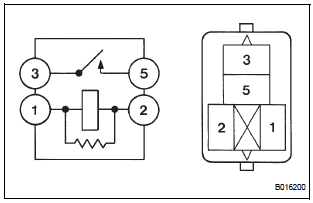
- Remove the A/F relay from the No. 6 engine room R/B.
- Measure the resistance according to the value(s) in the table below.
Standard resistance

- Reinstall the A/F relay.
13 CHECK HARNESS AND CONNECTOR (A/F SENSOR - ECM)
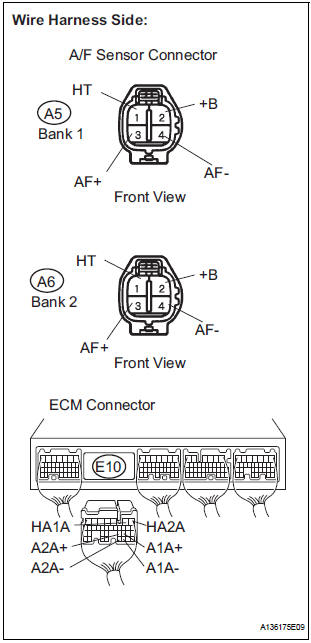
- Disconnect the A5 or A6 A/F sensor connectors.
- Turn the ignition switch to the ON position.
- Measure the voltage according to the value(s) in the table below.
Standard voltage

- Turn the ignition switch off.
- Disconnect the E10 ECM connector.
- Measure the resistance according to the value(s) in the table below.
Standard resistance: Check for open
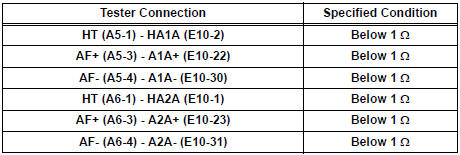
Check for short

- Reconnect the ECM connector.
- Reconnect the A/F sensor connectors.

14 REPLACE AIR FUEL RATIO SENSOR
- Replace the air fuel ratio sensor (for 2WD model or 4WD model
15 PERFORM CONFIRMATION DRIVING PATTERN
- Connect the intelligent tester to the DLC3 (Procedure A).
- Turn the ignition switch to the ON position and turn the tester on (Procedure B).
- Clear the DTCs (Procedure C).
- Select the check mode using the tester (Procedure D).
- Start the engine and warm it up with all the accessories switched off (Procedure E).
- Drive the vehicle at between 38 mph and 75 mph (60 km/h and 120 km/h) and at an engine speed of between 1400 rpm and 3200 rpm for 3 to 5 minutes (Procedure F).
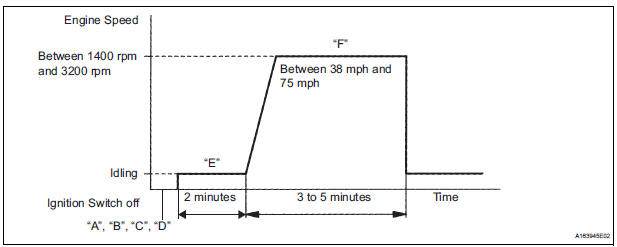
HINT: If the system is still malfunctioning, the MIL will be illuminated during procedure "F".
NOTICE: If the conditions in this test are not strictly followed, no malfunction will be detected.
16 CHECK WHETHER DTC OUTPUT RECURS (DTC P0171, P0172, P0174 OR P0175)
- Select the following menu items: DIAGNOSIS / ENHANCED OBD II / DTC INFO / PENDING CODES.
- Read the DTCs
Result

END
 Oxygen Sensor Circuit Malfunction/ Oxygen Sensor Circuit Low Voltage/ Oxygen
Sensor Circuit High Voltage
Oxygen Sensor Circuit Malfunction/ Oxygen Sensor Circuit Low Voltage/ Oxygen
Sensor Circuit High Voltage
DTC P0136 Oxygen Sensor Circuit Malfunction (Bank 1
Sensor 2)
DTC P0137 Oxygen Sensor Circuit Low Voltage (Bank 1
Sensor 2)
DTC P0138 Oxygen Sensor Circuit High Voltage (Bank 1
Sensor 2)
DTC P01 ...
 Fuel Pump Primary Circuit
Fuel Pump Primary Circuit
DTC P0230 Fuel Pump Primary Circuit
DESCRIPTION
This DTC is designed to detect a malfunction in the fuel pump
(FUEL PUMP) relay circuit. When the
system is normal, the battery voltage ...
Other materials:
Installation
1. INSTALL FRONT SHOCK ABSORBER WITH COIL SPRING
(a) Install the front shock absorber with coil spring as
shown in the illustration.
(b) Install the 3 nuts to the upper side of the front shock
absorber with coil spring.
Torque: 80 N*m (816 kgf*cm, 59 ft.*lbf)
(c) Install the 2 bolt ...
Unlocking and locking the doors from the inside
Door lock switch
Locks all the doors
Unlocks all the doors
Inside lock button
Locks the door
Unlocks the door
The front doors can be opened
by pulling the inside handle
even if the lock buttons are in
the lock position. ...
Short to B+ in Driver Side Squib 2nd Step Circuit
DTC B1183/22 Short to B+ in Driver Side Squib 2nd Step Circuit
DESCRIPTION
The driver side squib 2nd step circuit consists of the center airbag sensor
assembly, the spiral cable and
the steering pad.
The circuit instructs the SRS to deploy when deployment conditions are met.
DTC B1183/22 ...
